British and American keyboards
There are two major English language computer keyboard layouts, the United States layout and the United Kingdom layout defined in BS 4822[1] (48-key version). Both are QWERTY layouts. Users in the United States do not frequently need to make use of the £ (pound) and € (euro) currency symbols, which are common needs in the United Kingdom and Ireland, although the $ (dollar sign) symbol is also provided as standard on UK and Irish keyboards. In commonwealth countries such as Australia, Canada (English speaking parts), Pakistan, India, and New Zealand, the US keyboard is commonly used.
| Comparison of American and British English |
|---|
| Keyboards |
| Grammar |
| Speech |
| Spelling |
| Vocabulary |
|
|
| Works |
|
|
Windows keyboards
The UK variant of the IBM Enhanced keyboard commonly used with personal computers designed for Microsoft Windows differs from the US layout as follows:
- The UK keyboard has 1 more key than the U.S. keyboard (UK=62, US=61, on the typewriter keys, 102 v 101 including function and other keys)
- The Alt key to the right of the space bar is replaced by an AltGr key
- the extra key is added next to the Enter key to accommodate # (number sign) and ~ (tilde)
- The £ (pound sign) takes the place vacated by the number sign on the 3 key
- The ¬ (negation) takes the place vacated by tilde on the ` (grave accent) key
- ⇧ Shift+` produces ¬
- AltGr+` produces ¦ (broken bar, shown as a secondary symbol)
- € (euro sign) is produced by AltGr+4 and is shown as a secondary symbol
- @ and " are swapped (to ⇧ Shift+' and ⇧ Shift+2, respectively)
- the \ key is moved to the left of the Z key (⇧ Shift+\ still produces |)
- the Enter key spans two rows, and is narrower to accommodate the #/~ key
- Some UK keyboards do not label Backspace, Enter, Tab and Shift in words
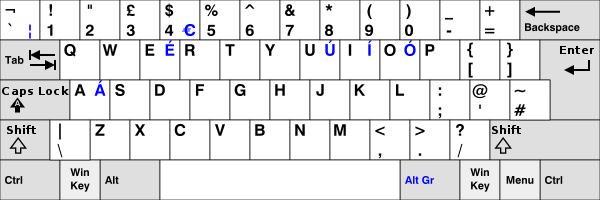

Early versions of Windows handled both the differences between the two keyboards and the differences between American English and British English by having two English language options — a UK setting and a US setting. While adequate for users in the United States, United Kingdom, and Ireland, this solution caused difficulty in other English-speaking countries. In many Commonwealth countries and other English-speaking jurisdictions (e.g., Canada, Australia, the Caribbean nations, Hong Kong, Malaysia, India, Pakistan, Bangladesh, Singapore, New Zealand, and South Africa), local spelling conformed more closely to British English usage, while the supplied keyboard was printed with the United States layout on the keys. People in these countries were forced to choose between a keyboard layout incompatible with their hardware, or having their spell checker software flag the British English spelling of words such as "colour", "centre", etc.
However, in more recent editions, the number of options was increased, allowing users to select the correct keyboard and dialect independently. For example, one is given a number of default options for locality that will usually correctly match dialect and keyboard. Further, even if the hardware keyboard layout does not match the device driver software layout that was pre-selected, it can be changed without changing the regional setting.
International or extended keyboard layouts
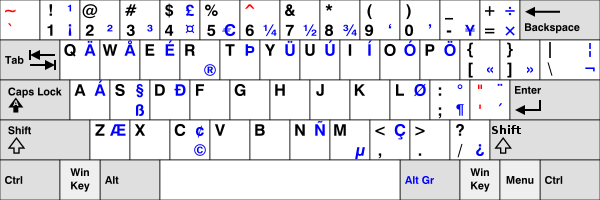
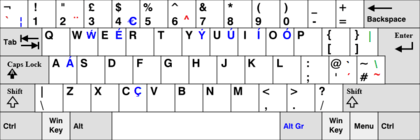
Since the standard US keyboard layout in Microsoft Windows offers no way of inputting any sort of diacritic or accent, this makes it unsuitable for all but a handful of languages unless the US International layout is used. The US International layout changes the ` (grave), ~ (tilde), ^ (circumflex), " (double quote, to make diaeresis), and ' (apostrophe, to make acute accent) keys into dead keys for producing accented characters: thus for example ' (release) a will produce á. The US International layout also uses the right alt (AltGr) as a modifier to enter special characters.[2]
The equivalent mapping for UK/Irish keyboards is called the "UK Extended" layout which, if activated in settings, will allow the user to enter a wide variety of diacritics (such as grave accents) which are not accommodated by the standard UK/Irish layout. In particular, à,è,ì,ò,ù used in Scots Gaelic can be made (using `, release and then the vowel), the ŵ and ŷ used in Welsh (using AltGr+6 (^), release, then w etc.). Likewise, the Spanish and Portuguese letters ñ and õ can be made (using AltGr+# (~), release, then n etc).
For more specialized uses, there is a facility in Windows for users to create a customized layout that may match their needs more precisely.[3]
Apple Macintosh keyboards
.svg.png)
The non-standard default U.S. layout on Apple Macintosh computers allows input of diacritical characters, whereby the entire MacRoman character set is directly available.
Apple supplies a "British" keyboard layout with the following differences:
- The # symbol is replaced by the £ symbol (as on PC keyboards); the # is available by pressing ⌥ Option+3
- More recent Apple British keyboards move the backquote/~ key to the left of the Z key and replace it with a section sign (§) and a plus-minus sign (±), respectively.
- The Enter key spans two rows and is shaped similarly to the Enter key of many ISO PC keyboards.
- The " and @ keys are swapped.
Other keyboard layouts



Other operating systems can optionally re-map the keyboard layout or have different modifier keys (for example the Amiga keyboard has "A" modifier keys and BBC Micro or Acorn keyboards often had a "Shift Lock" as well as a "Caps Lock").
Under Unix/Linux the "Windows" key is often called the "Super" key and can be re-mapped by users for specific functionality but in most programs by default does nothing.
Some older Unix/Linux software, such as Emacs, uses the left Alt key as a "Meta" key, which harks back to older MIT or LISP computers.[4]
Chrome OS uses the US and UK Windows layouts, except that the Caps-Lock key is labelled with a magnifying glass (🔍) and by default acts as a web search key (there is an option in Settings to revert it to convention). The function-key row ia also differently labelled. The UK-extended layout for Chrome OS is provided by a Chrome add-on, and provides ready access to a substantially greater (than Windows) repertoire of precomposed characters for western, central and eastern European (Latin alphabet) languages.
Dvorak layouts


There are also Dvorak Layouts for each region.
Typewriters
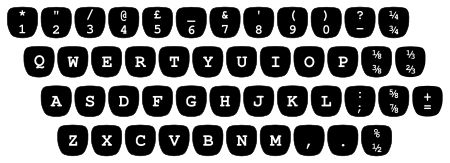 British typewriter keyboard layout, variant 1 (full) |
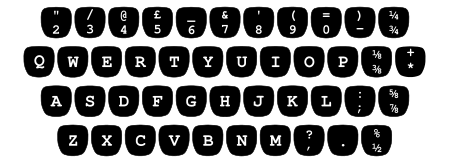 British typewriter keyboard layout, variant 2 (portable) |
 American typewriter keyboard layout |
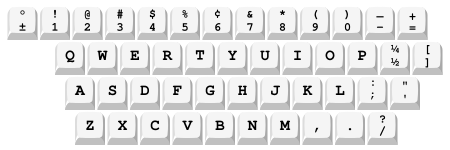 IBM Selectric American keyboard layout (the predecessor of the modern US layout) |
References
- British Standard BS 4822: Keyboard allocation of graphic characters for data processing. British Standards Institution, 1994.
- "Using the US International Keyboard Layout" (PDF). College of Saint Benedict and Saint John's University . Retrieved 14 December 2019.
- Dan Price (21 August 2018). "How to Create a Custom Keyboard Layout on Windows". makeuseof.com. Retrieved 14 December 2019.
- Meta key